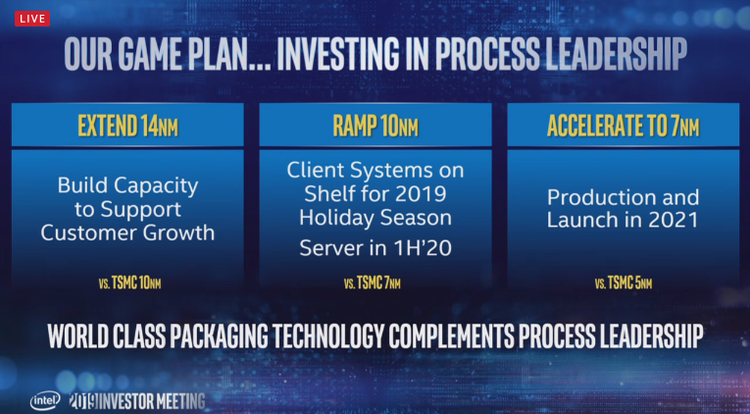Intel To Ship 10nm CPUs In June, Launch 7nm GPUs In 2021
'They've gotten behind before and have been able to catch up and pass them by once. They're definitely a company that can rebound and recover and still be a very strong competitor,' an Intel partner says of the chipmaker's race to release 10nm products against AMD's upcoming 7nm products.

Intel plans to start volume shipments of its 10-nanometer Ice Lake mobile processors in June with the first devices sporting the new CPUs still set to launch for the 2019 holiday season.
The announcement was among several disclosures the Santa Clara, Calif.-based semiconductor giant made during its 2019 meeting with investors on Wednesday, which Intel has been broadcasting live.
[Related: Intel CEO Bob Swan To Investors: 'We Let You Down' But We'll Improve]
The chipmaker said the company plans to launch multiple 10nm products throughout 2019 and 2020, including a 10nm server processor that is planned for a "fast follow" next year. Among the other 10nm products planned for this time frame is one of the company's first general purpose GPUs, additional CPUs for client computers, the Intel Nervana NNP-I inference processor, the Intel Agilex family of FPGAs and the company's "Snow Ridge" 5G-ready network system-on-chip.
For the first time, Intel provided a timeline for the manufacturing process technology that will follow 10nm: 7 nanometer. The company said its lead 7nm product will be a general-purpose GPU for artificial intelligence and high-performance computing workloads in the data center that will launch in 2021. The discrete graphics technology will be based on the company's new Intel Xe architecture.
“While process and CPU leadership remain fundamentally important, an extraordinary rate of innovation is required across a combination of foundational building blocks that also include architecture, memory, interconnect, security and software, to take full advantage of the opportunities created by the explosion of data,” Murthy Renduchintala, Intel's chief engineering officer, said during the meeting. “Only Intel has the R&D, talent, world-class portfolio of technologies and intellectual property to deliver leadership products across the breadth of architectures and workloads required to meet the demands of the expanding data-centric market.”
Intel said its 10nm process technology will deliver roughly "3 times faster wireless speeds, 2 times faster video transcode speeds, 2 times faster graphics performance, and 2.5 to 3 times faster artificial intelligence performance over previous generation products."
The 7nm process technology, in the meantime, will "deliver 2 times scaling and is expected to provide approximately 20 percent increase in performance per watt with a 4 times reduction in design rule complexity," according to the company.
Beyond the company's new disclosures around 10nm and 7nm products, Renduchintala shared more details around the company's new 3D packaging technology called "Foveros" that enables the integration of multiple IP blocks that are based on different process technologies.
The company's first design using this new technology is a client platform code-named "Lakefield" that was first revealed at CES. The platform includes a hybrid CPU architecture that combines a 10nm Sunny Cove core for high performance and four Atom-based cores for low-power efficiency.
Renduchintala said Lakefield will provide an improvement in system-on-chip standby power by a factor of 10, a two-fold increase in graphics performance, a reduction in printed-circuit-board area by a factor of two and up to a two-fold increase in active system-on-chip power. The executive said this means OEMs will have more flexibility in designing thin and light form factors for devices.
Dominic Daninger, vice president of engineering at Nor-Tech, a Burnsville, Minn.-based high-performance computing system builder and Intel partner, told CRN that while Intel has fallen behind in its original schedule for 10nm products, the company could still make a comeback against AMD like it has in the past when its rival has been first-to-market with new products. The partner called to mind Intel's strong response to AMD becoming the first chipmaker to ship a 1 GHz processor.
"They've gotten behind before and have been able to catch up and pass them by once," he said. "They're definitely a company that can rebound and recover and still be a very strong competitor."
AMD, in the meantime, said it plans to launch its first 7nm EPYC "Rome" server processors, as well as its first 7nm Radeon Navi client GPUs, in the third quarter. The company's 7nm Ryzen processors are still set for a mid-2019 launch, according to an AMD spokesperson.
"Competition's good," Daninger said. "It makes all the players better."